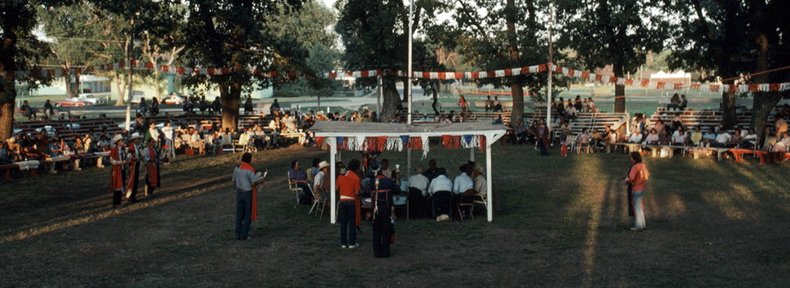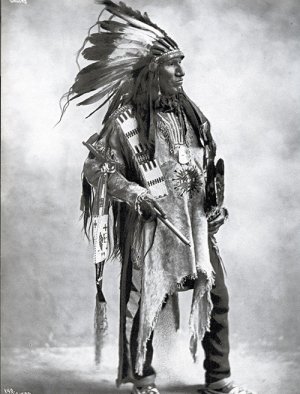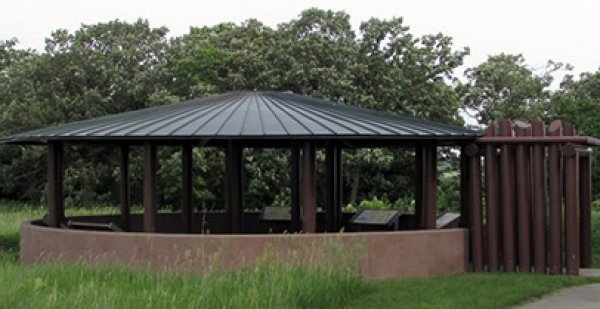The Omaha are a federally recognized Native American tribe who live on the Omaha Reservation in northeastern Nebraska and western Iowa, United States. The Omaha Indian Reservation lies primarily in the southern part of Thurston County and northeastern Cuming County, Nebraska, but small parts extend into the northeast corner of Burt County and across the Missouri River into Monona County, Iowa.
Its total land area is 796.355 km2 (307.474 sq mi) and a population of 5,194 was recorded in the 2000 census. Its largest community is Macy.
The Omaha tribe began as a larger woodland tribe comprising both the Omaha and Quapaw tribes and lived in the area near the Ohio and Wabash Rivers. As they moved farther West, the tribes split, with Quapaw tribe moving into what is now Arkansas and the Omaha tribe, known as U-Mo’n-Ho’n (“upstream”) settling near the Missouri River in what is now northwestern Iowa.
In 1700, Pierre-Charles Le Sueur, a French fur trader and explorer, was the earliest white man to write reports of the Omaha Tribe while trading with local Dakota bands in what is now Minnesota. He was told about an Omaha village with four hundred dwellings and a population of about four thousand people. It was located on the Big Sioux River near its confluence with the Missouri River, near present-day Sioux City, Iowa. The French then called it “The River of the Mahas.”
When French fur trappers first entered the region in the middle of the seventeenth century, the Omaha lived above the Big Sioux River and the eastern side of the Missouri River. They lived there for many years. Among their close neighbors were the Iowa, Oto and Winnebago tribes. During this time, historians believe the Omaha roamed as far north as the Cheyenne River in South Dakota to the Platte River in Nebraska. Later, Lewis and Clark found the Tribe across the Missouri to the south of Sioux City, Iowa.
Omaha villages were temporarily established for an eight-to-fifteen-year period of time. Attacks from the Sioux Tribe and disease often meant the relocation of the villages. Each village was made up of fifty to a hundred dwellings with villages located in the present day areas of Bellevue, and Homer, Nebraska and along the Papillion River. While the Omaha had used bark huts as homes in their former woodland culture, tipis and earthen lodges became more practical in their new lands along the Missouri River.
Around 1800, a smallpox epidemic, resulting from contact with Europeans, swept the area, reducing the tribe’s population by killing approximately one-third of its members. Chief Blackbird was among those who died that year. Blackbird had established trade with the Spanish and French, and used trade as a security measure to protect his people. Aware that they traditionally lacked a large population as defense from neighboring tribes, Blackbird believed that fostering good relations with white explorers and trading were the keys to their survival. The Spanish built a fort nearby and traded regularly with the Omaha during this period.
As to all plains tribes and cultures, buffalo were necessary to the tribe’s survival and livelihood. Almost every part of the buffalo was used for food, clothing, tools, rope, even hairdressing and lotion. However, as the large buffalo herds vanished from the plains, the Tribes were forced to abandon some of their means of self-support, resulting into a fatal dependency upon the government and the dominate culture.
Additional land cessions and negotiations occurred for the next fifty years, including the Dawes Act of 1882 which partitioned the Omaha’s land into 160-acre parcels, much like the Homestead Act did for White settlers. However, the whole notion of “owning land” was foreign to the Tribe. The Severalty Act of 1887 finally allowed Indians to become citizens of the United States. However, citizenship would not be uniformly given until 1924.
Dramatic changes to the Omaha way of life occurred from their first contact with white fur traders and settlers, who introduced new tools, materials, religion and commercial values such as bartering to the Tribe. Hunting and growing food for profit destroyed the spiritual aspects of those activities and along with it, the accompanying religious and ceremonial rites. Omaha bows and arrows were replaced by rifles, while Omaha pottery and wooden bowls and cups gave way to copper, tin and iron utensils.
As with so many other displaced eastern woodland cultures, the Omaha were nearly always caught between two aggressive forces -white settlers and western plains tribes. Both groups failed to appreciate the efforts of the Omaha Tribe to adapt to white economic and social customs, leaving the Tribe to endure the wrath of both groups. The advancing white population contributed to the depletion of the game and wildlife upon which the tribe had once dependent – both spiritually and materially. The Omaha were left at the mercy of well-armed Sioux war parties by the severe lack of rifles and other arms. The double fire of Indian enemies and the massive influx of white settlers brought much suffering to the Omaha, which was endured with “an heroic patience”. Determined to abide in the land of their fathers, resisting all pressure and offers to go to the Indian Territory, the tribe decided, in 1855, to sell their vast hunting lands and reserve the site of their ancient home on the banks of the Missouri and meet there as best they could the problem of their future.



